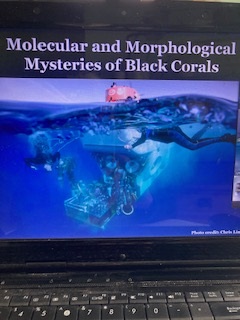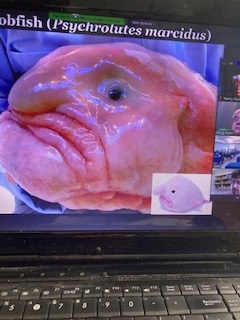Members and guests were welcomed by President Lynn King.
Kevin Courtney offered the prayer and led the pledge to the flag.
Announcements:
Lynn told all that the club has had a request from Outside Hilton Head to participate in Earth Day which is April 22. There will be several opportunities to volunteer including there will be another oyster bagging. More information to follow.
There was an online memorial service for Pete Adams who was known by many of our members. Many testimonies were shared and he was known as "one super guy". RIP, Pete Adams.
President Elect Kristin Keller collected Happy $$.
Speaker:

Lynn introduced our speaker, Dr. Mercer Brugler, Associate Professor of Marine Biology at USCB. He is a lecturer, adjunct professor, and conducts deep sea research. His academic missions is "to recruit, inspire and retain historically underrepresented minorities in the Marine Biology Program at the University of South Carolina Beaufort by leveraging priceless supoort and generous funding from USCB, the American Museum of Natural History, the Smithsonian Institution's National Museum of Natural History, the National Oceanic & Atmospheric Administration and the Flower Garden Banks National Marine Sanctuary. Undergraduates from 'Team Black Coral' have participated in NOAA funded research cruises, continued onto Masters Programs at Cornell University, Yale's School of Forestry & Environmental Studies, the University of Maryland Eastern Shore, the University of Louisiana at Lafayette, and Brooklyn College and are employed by Cold Spring Harbor's DNA Learning Center."

Dr. Brugler tries to recruit minority students to the Marine Biology field. They learn how to extract DNA and sequence it. The environment in which the research takes place is located between 30 and 150 m depth which is where corals, sponges and algae are the dominate creatures. Twice a year Dr. Brugler brings minority students with him to Flower Garden Banks where they collect samples. After the research cruises they set up exhibits and present their findings both locally and internationally. The Deep Sea covers 65% of the earth's surface and starts at 200 m depth and extends to 11,000 m. So far only 5% of it has been explored.

He shared a photo of the effect of pressure in the sea on a styro foam cup. He also talked about the vehicles used to perform deep sea research. One of them, "Alvin" costs $65,000 per day to go down. In addition to the areas that we might suspect to find deep ocean depths, the Hudson River has cut the largest canyon in the continental shelf, with depths of 200m to 4,000m and it is largely unexplored. It is known as "Hudson Canyon" We also learned that before they go to the sea floor they map the area, sending out sound waves. Typically they see so many animals that it is difficult to know where to start collecting. He talked about some of his favorite fish, the Blob fish:

being his favorite. He also showed fantastic pictures of several more, including the Angler fish which he explained its life cycle; snail which is endangered; giant squid which has 8 arms and is carnivorous, etc. He spoke of corals, black coral being one. They are upwards of 4,265 years old and the deepest coral fount at 8,600 m is called spiney coral. Worms and crabs all want to live on corals and the anatomy of black corals change based on what has lived on it. Black coral DNA changes super slow. He spoke of future plans, and has received a grant from NASA. There is a project going on to decode interspecies communication and it can be followed at projectceti.org. Local projects that he is working on is studying leeches and well as researching environmental DNA and oyster reefs which are bio diverse. Fascinating information .